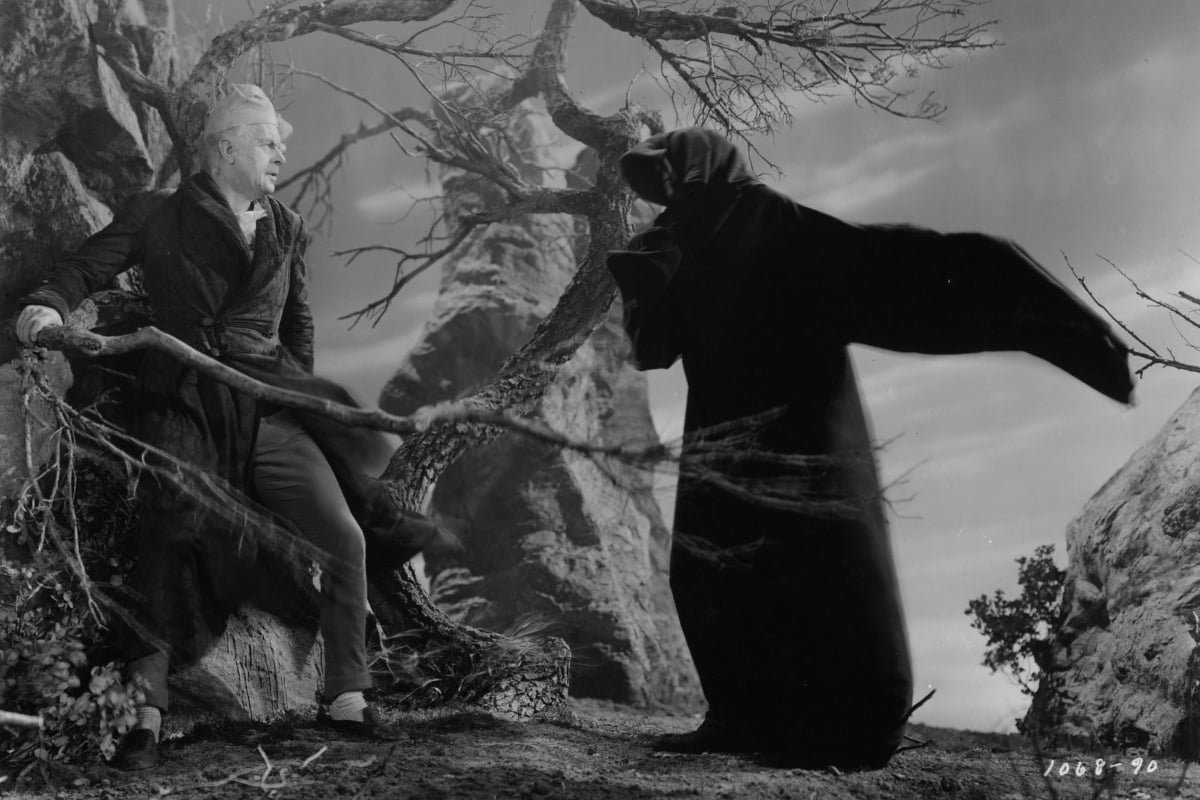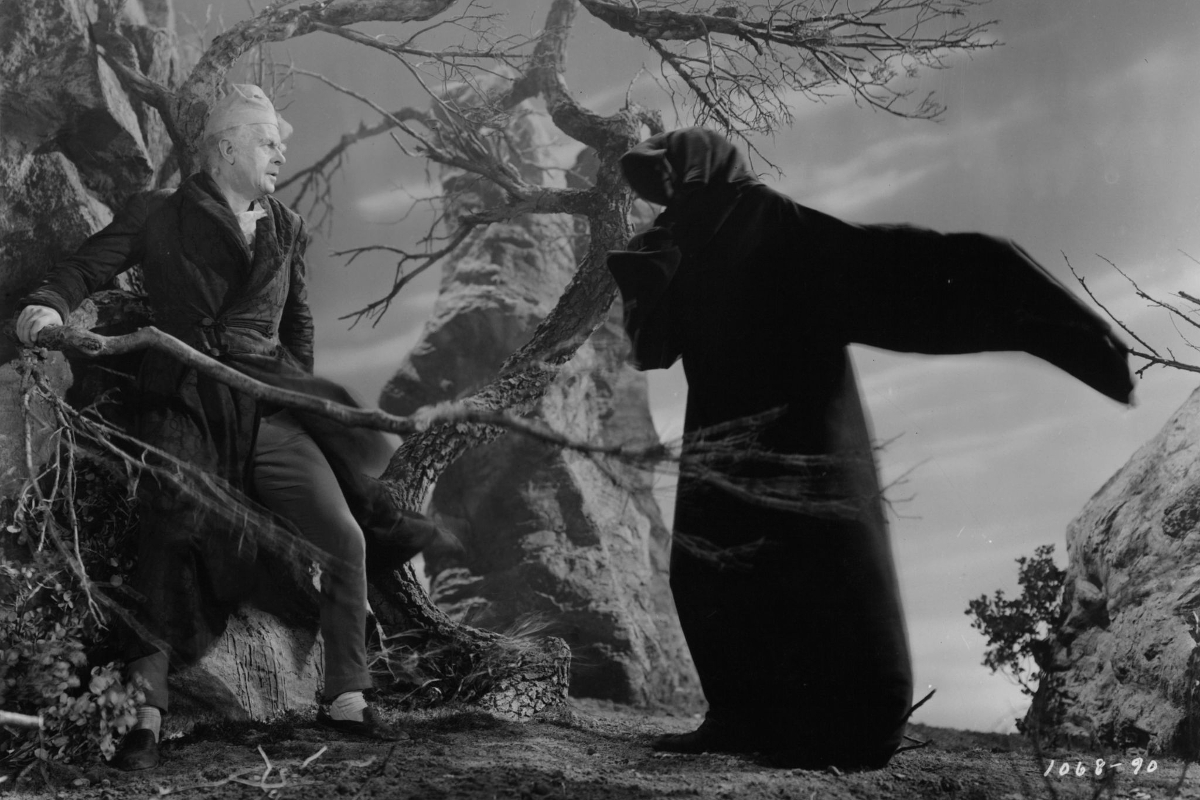
Christmas wasn’t always like this. It used to be spooky, and it’s high time to bring that back.
I can’t say for sure that the loss of this second spooky season is a direct result of the increasing plastic, corporate, Niceness that’s overtaken all of December, where everything has to be postcard-perfect and people smother layers of dysfunction under pictures of cinnamon rolls and matching pajamas—but I have my suspicions.
Despite (or maybe, at least in part, because of) the relentless festival of positivity that takes over every winter holiday season, this is one of the unhappiest times of the year for many. We have to deal with things like seasonal depression, financial pressures peaking, and, for many, reminders of loved ones we’ve lost and how we won’t be able to spend time with them this year. On top of that, we often feel societal pressure to act cheery and are shamed for being anything other than happy, smiley, and festive.
This is where the spooky side of Christmas has a role to play, because being able to acknowledge and even celebrate the dark is important. It’s healthy. And frankly, it’s a lot more fun than Hallmark.
Christmas ghost stories
Telling ghost stories was an integral part of Victorian Christmases, which becomes obvious the moment you think about A Christmas Carol, how it became a seasonal classic, and how no one ever seemed to question the fact that Dickens had basically written a horror story with a happy ending about that most sentimental of days.
The Turn of the Screw, which The Haunting of Bly Manor is based on (thereby technically making it a Christmas show if you want it to be), even uses that tradition as a framing device, with the audience gathered around the fire on Christmas Eve when the narrator uses his turn to tell that story. M. R. James, one of the great British horror writers, revitalised the tradition during his tenure at Kings College Cambridge, inviting a carefully selected group of guests to his rooms every year to read aloud one of his newest creations by the light of a single candle.
It’s incredibly Victorian actually, this merger of sentiment and terror at Christmas. You only have to look at their memento mori traditions, of hair jewelry and death photography, to see that the two emotional states were closely bound together for them.
Terrifying supernatural figures
It would be easy to imagine spooky Christmas as a Victorian invention, a product of their incredibly morbid, gothic aesthetic, but Christmas terror goes back a lot further, and can be found all over Europe. Krampus, of course, has made a comeback in recent years, but other terrifying supernatural figures, connected with both Christmas itself and the time of year surrounding it, also rampage across continental Europe every December.
There’s Perchta and Frau Hollen from the Alps, ladies who will rip out your guts and stuff you full of straw if you haven’t finished your allotted spinning for the year, failed to clean the house properly, or dare to eat anything other than fish gruel on the day of their visit. The Belsnickle from Germany (portrayed surprisingly accurately in The Office) and Père Fouettard in France turn up at people’s houses in upsetting costumes, to punish the bad as well as reward the good with whips and switches and cakes and nuts—doling out both at once because no one manages to be all good or all bad all the time.
Little Christmas monsters
Moving further south we find the kalikanzaroi, Christmas imps who you may recognize from their (inaccurate of course) portrayal in a Christmas episode of Grimm. Found in Turkey, Greece, Cyprus, and parts of the Balkans, these little monsters take a break from their underground mischief to cause problems for humans above the ground all through the 12 days of Christmas.
On the other side of the continent in Iceland, we have the Yule Lads (very accurately portrayed in The Chilling Adventures of Sabrina), a group of trolls who spend the 12 days leading up to Christmas stealing from and pranking humans, followed by their mother, Gryla who collects up naughty children to boil into stew. If that wasn’t dark enough there’s also their pet cat, the Yule Cat, a giant creature that eats anyone who didn’t receive new clothes for Christmas and, similarly to Gryla and Perchta, was used to frighten young people into finishing their fiber arts chores on time.
Iceland’s parade of Christmas horrors actually went so far that the island’s parliament in the 18th century outlawed using that traditional folklore to scare children into good behavior, insisting parents use a modified, less frightening version instead. Why don’t we have dozens of movies about them already? They’re so scary their country’s parliament literally banned telling children about them!
Miscellaneous Rascals™
But wait, there’s more! Because how could we forget the Mari-Lwyd? A charming horse skull on a stick, bedecked with ribbons and a white sheet as a dress/cape, that’s paraded all around the area by a group of Rascals™ demanding people let it inside to drink all their beer—and engaging in rhyming battles with the residents determined to keep it out. Or Lussi, the demonic witch queen of the Wild Hunt in parts of Scandinavia, and her followers, who ride out to terrorize mortals on the old date of the Winter Solstice.
There are so many of these figures—and of course there are, because winter is terrifying! If the weather doesn’t kill you, then diseases brought on by malnutrition and weakened immune systems, passed in close quarters might. Rot or mildew might ruin your food stores, leaving you to starve before spring, and hungry wolves might come in from the forests if their own prey grows scarce. And, if you survive all of that, there are unseen things out there, lurking in the long darkness, things that must be appeased and warded off, with greater than human powers.
Winter is frightening, and often sad, or physically painful to endure, and as much as we need joy and reminders of good things we need catharsis too, and to be able to look head-on at the dark and say there you are, I know you now.
Telling ghost stories around the fire, the processions of Krampus and Perchten with their terrifying masks, bothering all your neighbors with demands for alcohol while dressed up as some kind of Christmas monster or carrying a horse’s skull on a stick, these all provide that outlet. They let people bond through and overcome shared fears, they acknowledge and integrate those fears into seasonal ritual, making them less immense and easier to deal with. They even, sometimes, make them fun.
Our need for this hasn’t gone away, and I believe this is part of why there’s been a rise in Christmas-themed horror movies over the years. There’s horror in the way we celebrate Christmas now, in the deeply capitalist, often nationalistic, conformist pressures for suburban middle-class perfection that have been embedded in the holiday. We need to explore, unpack, and experience catharsis from them too. But they don’t actually tackle the sheer horrors of the season itself, the seemingly endless dark, the, sometimes literally, murderous cold, the instinctive sense that something, something unknowable and dangerous, is lurking out there beyond the circle of light. Bring back folk horror Christmas. Bring it into the cities*, not just the mountains and villages where it’s dug in stubbornly, refusing to die. Tell ghost stories, unrelated to Christmas itself but with the deep cold of winter embedded in their bones, to each other on winter nights when you’ve gathered together.
*Shout out to Salzburg and the other cities that have maintained their traditional frightening Christmas celebrations. We see you and we love it.
featured image: MGM)
Have a tip we should know? [email protected]
